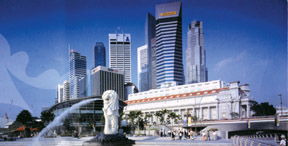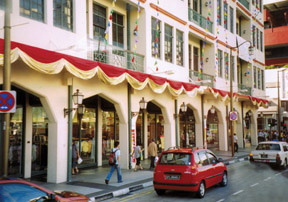|
observer |
|
|
|
|
|
OTHER LINKS |

|

|

|
|
Singapore: The land of Shangri-la for tourists and locals
While Singapore means the City of the Lion, visitors here, are allured by the mythical Merlion, with a lion's head and body of a mermaid, standing in ponds, in public places, with a fountain of water running out of its mouth. Equally curious for visitors, here, is the story of a quaint fishing village, which under 200 years ago, was inhabited by a little over a-hundred Orang Laut families (people of the sea), and today, transformed into the modern Singapore, of First World status. Remarkably, it took less than 40 years of independence for this change. Today, Singapore carries a population of 4.5 million. Most Singaporeans live in residencies amidst skyscrapers. The ethical homes of the past and the buildings of colonial Singapore blend in unison, preserved for posterity. There is room for expansion, in this dream city of town and country planning, acumen, with state-of-the-art infrastructure, and vegetation in the horizon. This economic mighty-atom island nation, bearing a negligible amount of natural beauty, recorded 8.3 million tourists in 2004. Singapore's projections of tourist arrivals in 2015 is 17 million, when tourism receipts are expected to grow to Singapore dollars 30 million, backed by the creation of 100,000 jobs; more jobs, means more products and services for the visitor. It is not just the political leadership of Lee Kuan Yew which transformed the island from row-boat-status, to command the skies in commercial aviation, which is the visitors' ponder. It is the culture and diligence of the Chinese which has been made use of, for its development. For, the Chinese like to toil as their ancestors did in mainland China, over millennia as worker-bees, obedient to the vision of their leaders. Today, the people of Singapore and its politicians are in harmony, devout to the philosophy of the beehive. And, when tourists from all over the world come here, they share the fruits of all that has gone on, in the quick span of time, and before.
In the mid-1980s tourists could visit the botanical gardens and the Tiger Balm Park, but now, there is much more. Tiger Balm Park is just a garden dedicated to a brand of balm, made by Chinese physicians. The park bears statues and stories of great Chinese warriors who were wounded in battle, and were relieved or cured with the use of that balm, and it touched the hearts of the visitors. Singapore tourism, also exploits to good gain, its multi-ethnicity and near perfect racial harmony. For the visitor, there are the Ethnic Quarters, Little India, China Town, Kampong Glam and Geylang Serai; all quarters provide products and services unique to their cultures and diverse ancestry, for the visitor to savour. Also, all the major religions, are represented, here, and you take a step back in time, when you visit a Chinese temple, Muslim mosque, Hindu temple and Christian church all in one neighbourhood. Outside the places of worship, religion does not look important, for the Chinese often call themselves nominal Buddhists, a measure of an emerging Singaporean culture of free thinkers, particularly, the young, as the tour guide explained, as tourist interest deepened. Also for the visitor, Singapore, the island city, with the sprinkling of many little islands surrounding it (most uninhabited), offers resort hotels, a Butterfly Park, Insect Kingdom, Bird Park, Night Safari, Zoo and Underwater World. At Raffles City, you can enjoy a high-tea buffet, 70 storeys in the air. The skyline being dotted with big-name hotels and booming-gun multinationals, gathers pace. The tour guide says, "before we go home by train, we stop at the railway stations; I never have dinner at home." True to her word, after dusk, the streets of Singapore are packed, locals outnumber visitors. The cuisine is Chinese, India, and all other ethnic dishes. The sidewalk restaurants are full, in a cavalcade of normal life, with tourists joining in, and the city never seems to sleep. Some hotels, cater more for the tourist, with food and cultural drama intermingled. The Chinese act their weddings, dragon dances by men and long-ribbon dances by girls, being a few in a variety of acts. Foreign transit passengers with five hours and more before their connecting flights can register for a free sightseeing tour. "When you're back for a longer visit, you may wish to slip into our rich past with a walking tour through our ethnic districts," the tour guide says. Singapore is a land of Shangri-la for tourists and locals. But for locals, the ethic is work and pleasure and no seeming age of retirement, where the very old are given easy tasks. Here, is also a shopping paradise, bursting with the latest lifestyle and fashion trends, from all over the world. Tourists like Singapore, because of its high disciplined nature, a girl is safe to walk the streets in the wee hours of the morning; there are no touts; if a taxi driver is found out with a rigged metre, he forfeits his taxi license for life. And, the tourist marvels and wonders, what Singapore will be 50 years from now? |










